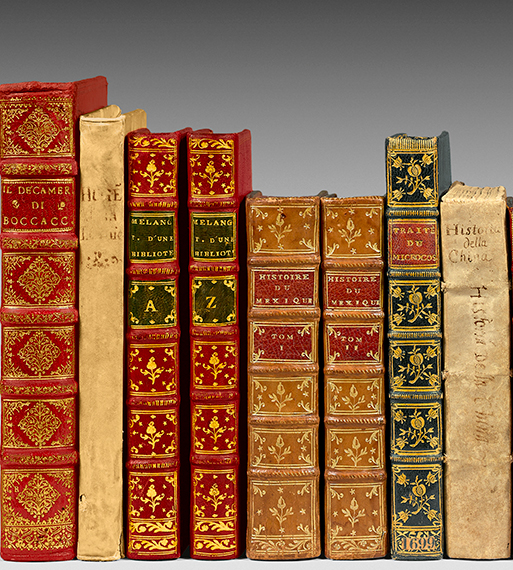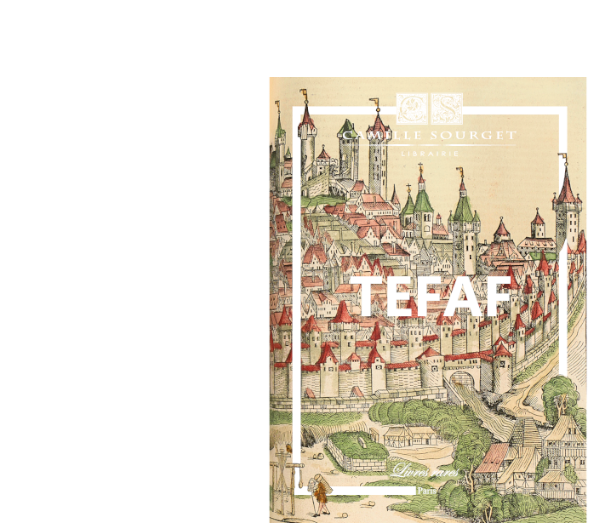One of the emblematic works of the culinary taste evolutions in France in the mid-17th century.
“Very beautiful copy in a charming binding of this interesting work by Nicolas de Bonnefons, valet of King Louis XIV” (Bulletin Morgand, 1893, no. 23436).
Provenances: Henry Huth (1815-1878); Alfred Henry Huth (1850-1910); James Toovey;
Comte de Mosbourg, 1893; Bulletin Morgand, 1893.
Paris, 1651.
Bonnefons, Nicolas de. The French Gardener, who teaches how to cultivate trees, and vegetable herbs; with the way to preserve the fruits, and make all kinds of jams, preserves, and marzipans. Dedicated to the ladies. Second corrected and augmented edition by the author.
Paris, Pierre Deshayes, 1651.
In-12 with 1 frontispiece, (24) pp., 380 pp., (2), 3 full-page plates. Red morocco, gold decoration on the boards variant of the frame with Duseuil, ribbed and floral spine, double gold fillet on cuts, gold interior roulette, gold edges on marbling. Trautz-Bauzonnet.
135 x 75 mm.
Second original edition augmented compared to the first published the same year 1651. It is so rare that Vicaire does not know it.
“Character both introduced at the court, where he holds the title of valet of the King, and rural owner engaging in the trade of trees and seeds, Nicolas de Bonnefons is one of the main representatives of the horticulture and vegetable growing vogue gaining French society during the 17th century. His French Gardener experienced great bookstore success from the original edition of 1651 and will be continuously reissued without significant change until 1737. While the first two parts of the book deal respectively with the cultivation of fruit trees and market gardens, the third and last consists of a confectionery treatise. Its main originality compared to other confectioners of the 17th century lies in the emphasis on conserving fruit without particular preparation: the book opens with a long discourse on domestic economy exposing the way to build an orchard and the various ways to preserve fruits in their natural state depending on their varieties, after which comes a chapter on fruits that can be naturally dried without being reduced to paste. The rest of the treatise belongs more to the art of the confectioner properly speaking, proposing recipes for both jams and sugar pastes to counterfeit various figures of foods and fruits—art of illusion that greatly contributed to the prestige of collation or the final service of fruit in feasts.” (Jean-Marc Chatelain).
“Engraved frontispiece, the 13 ff. preliminary are occupied by the title, “the epistle to the ladies” signed Rdcdwbdn and dated from Paris, July 1st, 1651, the “preface to the reader”, and the table.
The initials are, in reverse, those of the first name, last name, and quality of the author, Nicolas de Bonnefons, valet of the King.
The French Gardener is adorned, in addition to the frontispiece, with three figures, engraved by Chauveau, placed at the beginning of each of the three treatises that compose it. The first, representing a market garden where gardeners work and a lord and a lady walk, is before page 1; the second representing a garden, before page 117; and the third showing a kitchen interior, before page 245.
The first treatise occupies pages 1-116; the second, pages 117-244, and the third pages 244 to 380. This last concerns fruits, their storage, dry and liquid jam, as well as “marzipans” and macaroons.
The privilege is printed on the last leaf (recto and verso); it is dated “the 12th day of June 1651” and completed printing on “the first day of July” of the same year.
It must be believed that the success of the French Gardener was great because, first published in 1651, it was already at its fourth edition two years later, as can be seen on the following edition’s title.” (Vicaire).
One of the emblematic works of the culinary taste evolutions in France in the mid-17th century. The agronomist Nicolas de Bonnefons is “one of the main representatives of the horticulture and vegetable growing vogue gaining French society during the 17th century” (Jean-Marc Chatelain, in Books are food, Paris, BnF, Hermann, 2001, p. 147). It is within the circle of agronomists that the most decisive shifts in French cuisine occurred at the beginning of Louis XV’s reign, in the sense of a “new promotion of the notion of natural flavor, obtained through better exploitation of garden and orchard resources” (op. cit., p. 120). His work thus addresses these two aspects, which he closely links: the first two parts are devoted to the cultivation of fruit trees and market gardens, while “the third and last consists of a confectionery treatise. Its main originality compared to other 17th-century confectioners lies in the emphasis on conserving fruits without special preparation [This third part] belongs more to the art of the confectioner, proposing both jam recipes and sugar paste recipes to counterfeit various figures of foods and fruits—art of illusion that greatly contributed to the prestige of collation or the final service of fruit at feasts.” (op. cit., no. 120, for the original edition).
The present edition is adorned with 4 lovely figures engraved in intaglio signed by François Chauveau, one placed in the frontispiece.
Very beautiful copy in red morocco signed by Trautz-Bauzonnet.
Provenance: From the libraries of Huth; Alfred Henry Huth; James Toovey; the diplomat Michel Pierre Antoine Laurent Agar, comte de Mosbourg (ex-libris sticker on the verso of the first free endpaper); then Bulletin Morgand 32 no 23436.

